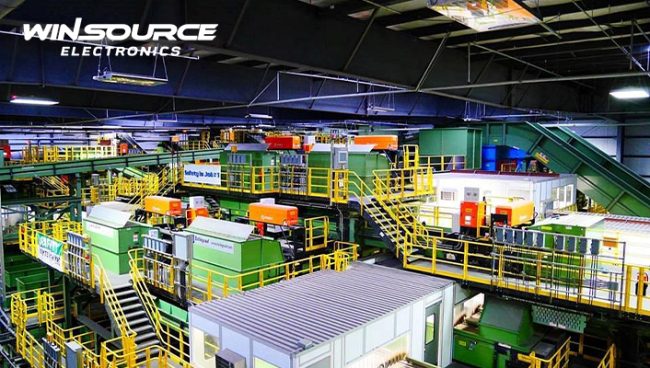
Electronic waste (e-waste) is one of the fastest-growing categories of waste worldwide, posing significant environmental challenges. It encompasses discarded electronic devices such as computers and mobile phones.
Table of Contents
ToggleThe Global E-waste Challenge
In 2019, a staggering 53.6 million metric tonnes of e-waste were generated globally, with predictions of an increase to 74.7 Mt by 2030. Increased electronic consumption, shorter product lifecycles, and limited repair options fuel this rise.
Impact on Global Greenhouse Gas Emissions
Escalating Emissions from E-Waste
The rapid increase in electronic waste has led to a corresponding rise in greenhouse gas emissions. Between 2014 and 2020, emissions from electronic devices and associated e-waste surged by 53%, contributing 580 metric tons of carbon dioxide in 2020 alone.
This alarming trend is projected to continue, with an estimated 852 million metric tons of CO2 emissions expected annually from e-waste by 2030 if no regulatory actions or changes are implemented.
Quantifying E-Waste’s Carbon Footprint
A study by the University of California, Irvine, led by Dr. Oladele Ogunseitan, focused on quantifying the carbon footprint of e-waste. This research underscores how e-waste significantly adds to the total greenhouse gases emitted into the environment.
Notably, the study highlights the necessity for strategies aimed at source reduction, including extending the lifespan of electronic products, which can directly impact the amount of waste generated.
High Emission Electronics in Electronic Recycling
Certain electronic products, such as flat-screen TVs, have the highest emissions, contributing to approximately 41% of the total emissions. It is followed by laptops, tablets, computer monitors, desktop computers, mobile phones, computer accessories, printers, and gaming consoles.
This significant contribution is concerning, given the prevalent use of these devices in modern households and businesses. Their ubiquitous presence in our daily lives magnifies their environmental impact.
Organizations like Sims Recycling play a crucial role in mitigating these impacts through their dedicated electronic recycling efforts. They focus on responsibly managing the disposal and recycling of these high-emission electronics.
Potential for Reducing Emissions
The study also posits that extending the helpful lifetime of information and communication technology could substantially reduce CO2 emissions. A hypothetical scenario estimated that a 50% to 100% increase in the lifespan of ICT devices between 2015 and 2020 could have prevented 19 to 28 million metric tons of e-waste.
The “3re” effort—reduce, reuse, and recycle—is seen as crucial in reducing the need for new products and thereby decreasing overall production-related emissions.
Broader Environmental and Health Impacts
The global dependence on information and communication technologies poses additional risks, including toxic e-waste exposure for around 30 million people living near e-waste recycling centers in various countries. This exposure often results in concentrations of hazardous metals in the environment exceeding permissible standards, posing significant health risks.
Towards Climate Neutrality in the Electronics Industry
The UCI study suggests that developing an international consensus on a legal framework to support eco-design, source reduction, repair, refurbishment, and reuse is essential. These strategies are vital to achieving climate neutrality in the electronics industry, which is currently among the top sectors contributing to the global carbon footprint.
Implementing these measures can significantly reduce the environmental impact of e-waste and contribute to international efforts against climate change.
Manufacturers’ Responsibility in E-waste Reduction
Manufacturers hold a key role in addressing the e-waste problem. By adopting circular economy principles, they can significantly reduce e-waste. Key strategies include:
A. Promoting the Right to Repair
Manufacturers can significantly reduce e-waste by promoting the right to repair. This involves making it easier for consumers to repair their electronic devices, providing necessary information and guides, and partnering with businesses that facilitate seamless repair experiences.
The popularity of repair cafés indicates a growing consumer desire for repairable products. By backing such initiatives, manufacturers can enhance their competitive edge while contributing to environmental sustainability.
B. Embracing Legislation and Sustainable Design
Anticipating and embracing tighter regulatory restrictions is crucial for manufacturers. This proactive approach not only aids in adapting operations sooner but also aligns with increasing consumer demand for sustainable products. Designing electronics for repairability and recyclability is essential.
For instance, using liquid-proof coatings protects devices from water damage and makes them easier to repair, thus preventing the need for complete replacements.
C. Implementing Recycling Programs
Creating and managing in-house recycling programs allows manufacturers to reclaim usable elements from e-waste. By encouraging consumers to return old or broken devices, manufacturers can ensure that these products are recycled, refurbished, or responsibly disposed of, thereby closing the loop in the product lifecycle.
D. Supporting the Circular Economy
The circular economy model offers a sustainable alternative, where manufacturers focus on reusing resources to reduce e-waste. This approach involves reusing materials from one device to another, thus extending the life of electronic components and contributing to environmental protection.
Companies like Polycase, known for their electronic enclosures, play a crucial role in this model by providing durable and reusable components that fit this sustainable framework.
The Broader Impact of E-waste
The global increase in e-waste has broader implications, including the exposure of millions to toxic e-waste, particularly in major recycling centers in various countries. This exposure has significant health risks due to hazardous metals in the air, water, and soil.
The rise of global e-waste and its impact on greenhouse gas emissions and public health highlight the urgent need for sustainable waste management practices. Electronic manufacturers are also responsible, as they can implement strategies to reduce e-waste and support the circular economy.
By collectively adopting these sustainable practices, the adverse effects of e-waste on global warming and the environment can be mitigated.
Discover rare and essential electronic components at WIN SOURCE – your trusted destination for obsolete, hard-to-find parts. Visit now and experience unparalleled service!

COMMENTS